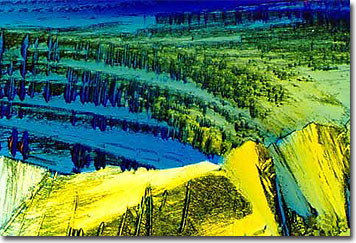Loes Modderman
Cupric Sulfate
Cupric sulfate, the best known and most widely used of the copper salts, is also commonly known as blue vitriol, or blue stone. Occurring naturally in the minerals chalcanthite, hydrocyanite, and brochantite, cupric sulfate is synthetically prepared by treating copper oxides with sulfuric acid.

|
View another digital image of recrystallized cupric sulfate taken with the optical microscope. |
Commercial industries, agriculture, and veterinary medicine use this versatile copper salt extensively. For instance, cupric sulfate is widely used in copper plating, wet-cell batteries, pigments, insecticides, and algaecides, and anhydrous forms of this blue, crystalline hydrate are employed as desiccating agents. Cupric sulfate is also commonly used as an algaecide and fungicide. Fertilizer additives, and topical anti-fungal preparations are additional areas in which cupric sulfate is employed.
Bright, blue-colored crystals are characteristic of cupric sulfate. Crystal formations of cupric sulfate actually begin as copper (II) sulfate, a compound that typically occurs as white rhombohedral crystals, or amorphous powders. After being dissolved in water, the striking, blue crystalline structures for which cupric sulfate is known begin to form. The uptake of water into the copper sulfate molecule creates the hydrate or water-containing compound. Each pentahydrate structure of blue vitriol is comprised of a group of five molecules of water that combine with a single molecule of copper sulfate. The water component of this hydrate structure is called water of crystallization. Heated above 150 degrees Celsius, the water of crystallization is driven off to leave an anhydrous salt compound. Pentahydrates, and the resultant dehydrated substances exhibit different properties in color, density, and crystal structure.
BACK TO LOES MODDERMAN GALLERY
